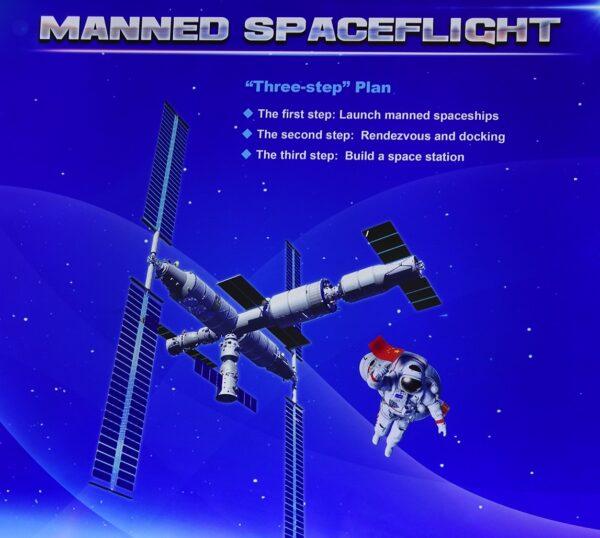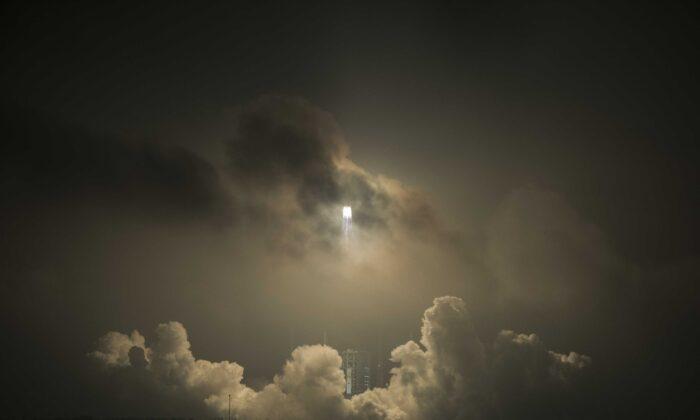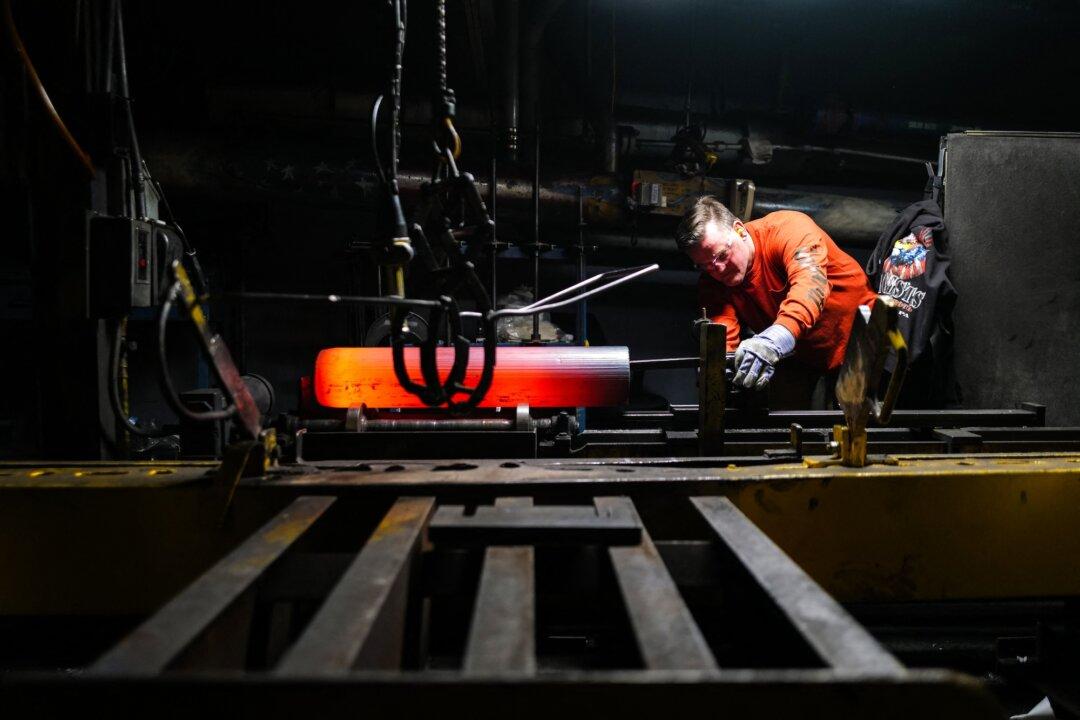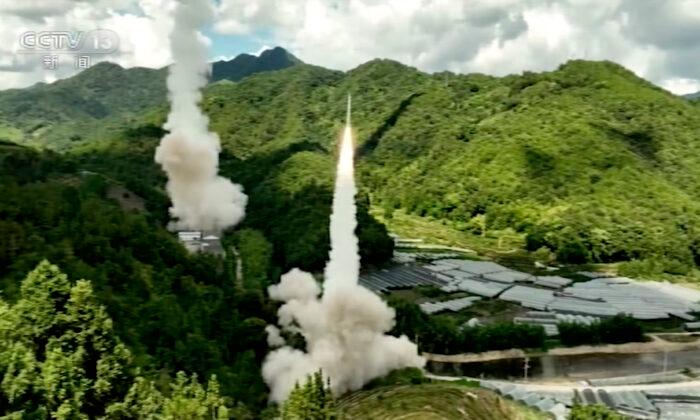By late April or early May, it’s expected that China will have started the construction of its first large space station. Given its importance to the larger ambitions of the regime in Beijing, it should be called Space Station Hegemony.
“China’s space station construction has come close to the implementation stage,” the Global Times reported on Jan. 14, citing the China Manned Space Engineering Office.
The Global Times also stated that “China will carry out 11 launches, including four manned spaceships and four cargo spaceship flights in the next two years, as it aims to complete the building of the country’s first space station by around 2022.”
The other three launches will orbit the three main modules of the early version of the space station. The Chinese name for the space station is Tiangong (Heavenly Palace); the first habitation module will be called Tianhe (Heavenly River). It will weigh about 22 tons and have an internal area of about 50 square meters (about 538 square feet).
This will be followed by two experimental modules that will also deploy the space station’s two main solar power arrays. These modules are called Wentian (Quest for Heavens) and Mengtian (Dream of Heavens). The station will be supplied and probably powered by regular eight-ton Tianzhou (Heavenly Vessel) supply ships.
China’s space station reportedly will have a regular crew of three, and the whole station will have a lifespan of about 10 years. In its early stages, this space station could weigh up to 100 tons, but subsequent additions could see its weight increase to 140 to 160 tons. Larger size likely means accommodations for additional crew.

The size of the crew modules is limited by the 25-ton to low Earth orbit (LEO) lifting capacity of the five-meter (about 16 feet) diameter Long March 5 space launch vehicle (SLV), currently China’s largest SLV.
China has been working toward the Tiangong space station since at least 1992, when China began its three-part 921 Program of early manned operations—its Shenzhou manned spaceships, then its Tiangong early manned space station, and then its early unmanned moon probes.
While the Shenzhou was based on purchased Russian Soyuz spacecraft plans and technology, in 2009, Russian sources told this analyst that China basically stole Russian technology to develop its early space station. This explains why the Tianhe module looks like a slightly longer Russian company Energia’s MIR space station module. It also serves as a cautionary tale ahead of allowing Chinese astronauts to board the International Space Station (ISS).
Like all other aspects of China’s space program, its space station will be controlled by China’s People’s Liberation Army (PLA). This means that beyond the expected scientific and commercial activities, China’s space station will have two more important missions.
First, China’s space station will likely perform military surveillance, and even potential combat missions. This is made easier by its modular construction; additional armed modules can be launched under a deceptive guise, again copying the Energia concept that would have also produced an armed MIR station, had the Soviet Communist Party survived into the 1990s.
In the early moments of a conflict with China, the United States and other countries may hesitate to attack a manned Chinese space station, possibly giving the PLA sufficient time to attack U.S. and other satellites, or targets on Earth with kinetic or energy weapons.
China, however, may have little hesitation to attack the manned 15-nation coalition, 417-ton ISS. In September 2008, China’s Shenzhou-7 very likely conducted a simulated interception-attack against the ISS.
Beyond its potential use in wartime, China’s space station will perform a critical political-military mission by serving as the focal point for Chinese recruitment of a space partnership coalition. China will then use such a coalition to normalize its presence on the Moon, which in turn advances its quest for hegemony on Earth.
In 2022, Pakistan expects to launch its first astronaut to the Chinese space station. This will gift Pakistan’s military authoritarian government with a hero who may beat into space India’s first astronauts on their Gaganyaan spacecraft, not expected until the end of 2022 or early 2023. The prospect of such a propaganda “coup” may help Pakistan agree to station Chinese military ships and aircraft at the Chinese-built port of Gwadar, assisting the PLA’s projection into the Indian Ocean, to the Persian Gulf, and to Africa.
Possible future Chinese space station visitors from Nigeria, Algeria, Venezuela, and Argentina, countries with either arms sales or space program relationships with China, might then welcome Chinese military access to their strategically located ports.
Countries welcomed aboard its space station become likely candidates for selection to work on China’s future lunar bases. In the 2030s, China may have the intention to rapidly build up to 10 such Moon bases. Having an international crew cohort may be helpful in building political support for any Chinese actions on the moon that may undermine, or run counter to, American and allied lunar objectives or international treaties and agreements.
Success on its LEO space station and then on the moon could enable China to build a network of larger space-based solar power satellites to help achieve energy independence, which could greatly assist China’s quest for hegemony on Earth.
China’s first-generation space station, and the possibility that it will build a much larger second-generation station, puts pressure on Washington to try to sustain the ISS for as long as possible. Since the mid-2000s, Russia has been mulling plans for divorcing some of its modules from the ISS to build a new but smaller Russian space station. India may also have a small space station by the early 2030s.
There has been some enthusiasm for increasingly turning the ISS over to private sector companies and, indeed, they could also build independent small space stations should the ISS not survive the decade. But to sustain its international space coalition, it may be more “profitable” for the United States to continue the Artemis Program to build a large human presence on the moon that involves many allies, partners, and friends.





